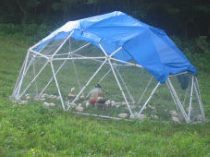For release: Jan. 12, 2016
MTSU News and Media Relations contact:
Randy Weiler, 615-898-5616 (office), 615-785-1196 (cell) or Randy.Weiler@mtsu.edu
MTSU Aerospace contact:
Doug Campbell, 615-898-5832 (office) or Doug.Campbell@mtsu.edu
MTSU Biology contact:
Dr. Ryan Otter, 615-898-2063 (office) or Ryan.Otter@mtsu.edu
MTSU College of Basic and Applied Sciences Development contact:
Nicole Chitty, 615-898-5003 (office) or Nicole Chitty@mtsu.edu
Twitter: @MTSUNews
Alumnus inventor gives MTSU
domes for drone, spider research
MURFREESBORO — Alumnus John Hurt’s unique donations of geodesic domes to the MTSU aerospace and biology departments will aid unmanned aircraft systems and spider research for students and faculty.
Hurt (Class of ’82) owns Buffalo Valley, Tennessee-based Zip Tie Domes, which makes 10- to 25-foot structures primarily used for chicken coops and greenhouses.
To view video from the December building of a dome at the MTSU Farm in Lascassas, Tennessee, visit https://youtu.be/k9Jems_AYig.
A pre-law and political science major while attending MTSU, Hurt received a U.S. patent for his geodesic dome kits in 2013, and later patents from New Zealand, Australia and the United Kingdom. The one-time computer programmer left after working 30 years for the state of Tennessee. He started Zip Tie Domes in May 2014.
Through his inventive efforts, Hurt’s university generosity includes:
- Loaning the MTSU Jennings A. Jones College of Business a dome for a team-building class project.
- Giving two 10-foot domes for biology associate professor Ryan Otter’s spider research.
- Giving one to aerospace that was constructed in December at the MTSU Farm for the UAS program.
- Providing three domes for Tennessee Technological University in Cookeville, Tennessee, for poultry research.
“I just wanted to help,” Hurt said of his geodesic dome donations. He added he is “open to building another one” at the farm.
The domes are constructed with 1.5-inch PVC pipe. Stainless steel zip ties hold adjoining ends together. Once the top is added, the dome becomes a solid piece, Hurt said.
Aerospace’s unmanned aircraft (drone) program will use the dome for testing and evaluation purposes in the enclosed environment, said Doug Campbell, who manages the UAS program.
“When we apply to the Federal Aviation Administration for permission to fly our unmanned aircraft out here, the first thing we have to ensure is that the aircraft is air-worthy,” Campbell said. “Doing air-worthiness evaluation, doing the hover checks, doing build checks on aircraft we’ve constructed either from kits or individual components and sharing that that build is of sufficient quality to be air-worthy is the objective.”
Development Director Nicole Chitty said the College of Basic and Applied Sciences is really excited the domes have been given to aerospace and biology.
“The domes will be a tremendous help to students in these aerospace and biology programs,” she said.
Biology associate professor Otter said the domes will become “artificial habitats for use in our field work” related to the Kingston, Tennessee, coal ash spill in December 2008.
“In my lab, we work with spiders that live at the edges of rivers and lakes and when we collect spiders we look on the tree branches that overhang the water,” Otter added. “With these domes, we are hoping to build artificial habitats that spiders will use, so we improve our collection efficiency. We are very optimistic and think they can really help us in our field research.”
Notes: • A video link is available at https://youtu.be/k9Jems_AYig








